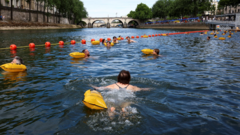The River Seine has officially reopened to swimmers for the first time in a century, a momentous occasion for Parisians and visitors alike. This seasonal revival is seen as a significant milestone in preparation for the Paris 2024 Olympics, where open water events, including triathlons, will be held in the iconic river.
Starting Saturday at 08:00 local time (07:00 BST), early risers gathered at designated swimming spots, eager to be among the first to dive in following the ban that lasted since 1923. Three specific locations along the Seine have been opened to the public: one near the Eiffel Tower, another adjacent to the Notre Dame Cathedral, and a third situated in eastern Paris.
Each of these areas is equipped with changing facilities, showers, and lounge furniture, accommodating up to 300 bathers at a time. The swimming sites will remain open for free until the end of August, with scheduled hours for swimmers ages 10 and older, depending on location. Lifeguards will oversee safety at the sites, ensuring a secure environment for all participants.
The long-anticipated lifting of the swimming ban has roots dating back to 1988, when Jacques Chirac, the then-mayor of Paris and future president, first called for action. Over the past two decades, substantial efforts have been made to clean up the Seine, leading to a significant decrease in waterborne contaminants.
Just before the Olympics, the city invested over €1.4 billion (approximately $1.6 billion) to enhance the river's water quality. However, some concerns arose last year regarding the river's readiness for the Games, particularly after rainfall events led to pollution spikes. To assuage doubts, Paris Mayor Anne Hidalgo led by example, wading into the Seine herself, demonstrating its safety for swimming.
This reopening not only marks a new chapter in Paris’s relationship with its river but also creates excitement around sustainable urban living and setting a vibrant backdrop for the forthcoming Olympic Games.
Starting Saturday at 08:00 local time (07:00 BST), early risers gathered at designated swimming spots, eager to be among the first to dive in following the ban that lasted since 1923. Three specific locations along the Seine have been opened to the public: one near the Eiffel Tower, another adjacent to the Notre Dame Cathedral, and a third situated in eastern Paris.
Each of these areas is equipped with changing facilities, showers, and lounge furniture, accommodating up to 300 bathers at a time. The swimming sites will remain open for free until the end of August, with scheduled hours for swimmers ages 10 and older, depending on location. Lifeguards will oversee safety at the sites, ensuring a secure environment for all participants.
The long-anticipated lifting of the swimming ban has roots dating back to 1988, when Jacques Chirac, the then-mayor of Paris and future president, first called for action. Over the past two decades, substantial efforts have been made to clean up the Seine, leading to a significant decrease in waterborne contaminants.
Just before the Olympics, the city invested over €1.4 billion (approximately $1.6 billion) to enhance the river's water quality. However, some concerns arose last year regarding the river's readiness for the Games, particularly after rainfall events led to pollution spikes. To assuage doubts, Paris Mayor Anne Hidalgo led by example, wading into the Seine herself, demonstrating its safety for swimming.
This reopening not only marks a new chapter in Paris’s relationship with its river but also creates excitement around sustainable urban living and setting a vibrant backdrop for the forthcoming Olympic Games.




















